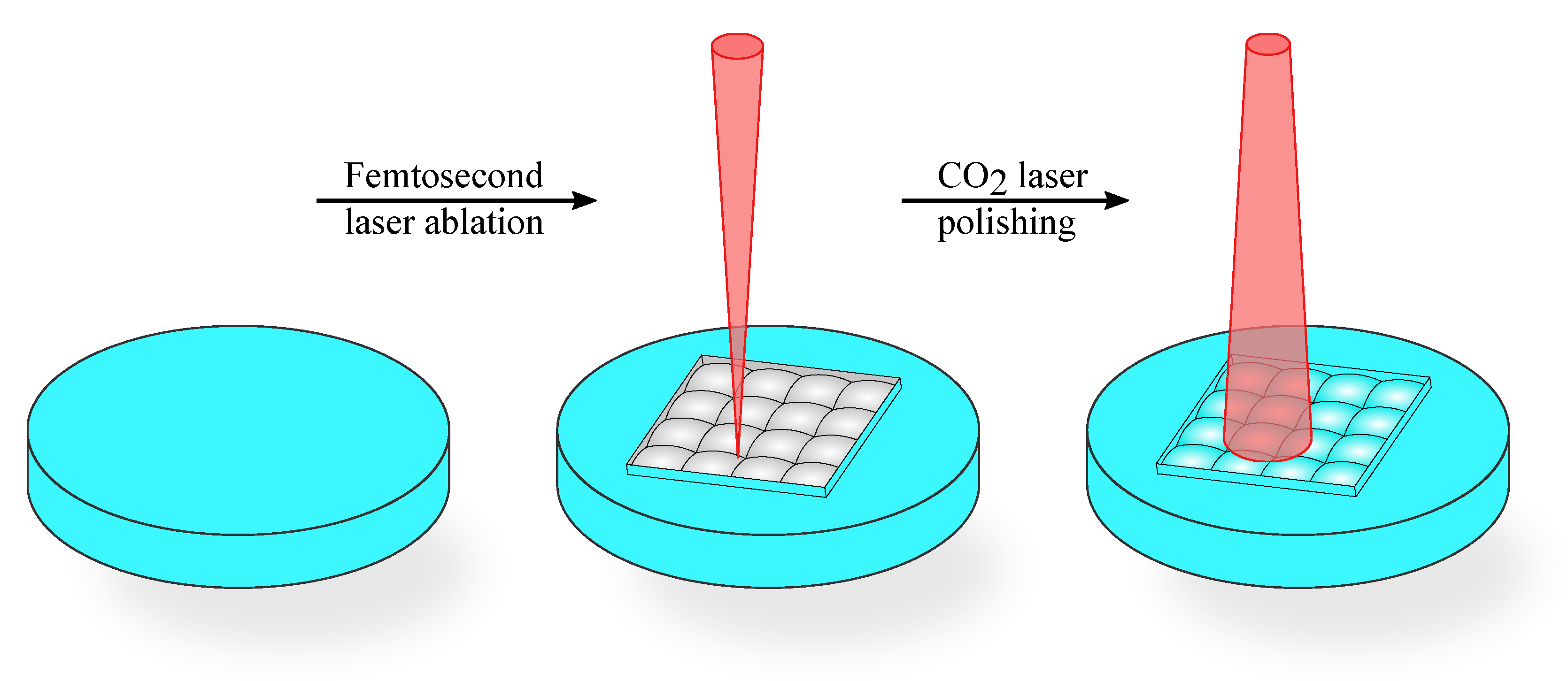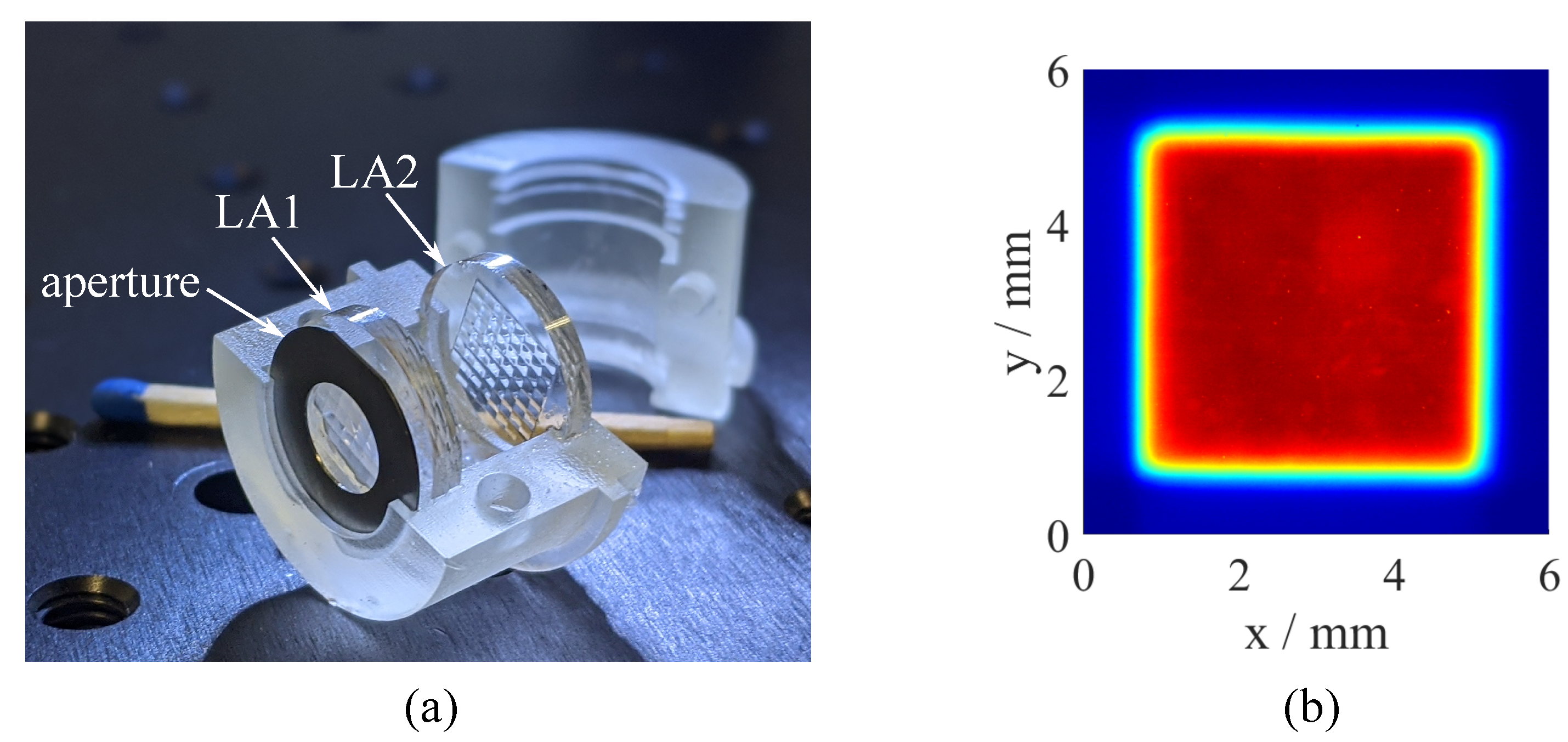Compact Beam Homogenizer Module with Laser-Fabricated Lens-Arrays
Abstract
:1. Introduction
2. Experimental
3. Results and Discussion
4. Conclusions
Author Contributions
Funding
Institutional Review Board Statement
Informed Consent Statement
Data Availability Statement
Conflicts of Interest
References
- Platt, B.C.; Shack, R. History and principles of Shack-Hartmann wavefront sensing. J. Refract. Surg. 2001, 17, 573–577. [Google Scholar] [CrossRef]
- Orth, A.; Crozier, K. Microscopy with microlens arrays: High throughput, high resolution and light-field imaging. Opt. Express 2012, 20, 13522–13531. [Google Scholar] [CrossRef] [PubMed] [Green Version]
- Wu, M.H.; Whitesides, G.M. Fabrication of two-dimensional arrays of microlenses and their applications in photolithography. J. Micromech. Microeng. 2002, 12, 747–758. [Google Scholar] [CrossRef]
- Möller, S.; Forrest, S.R. Improved light out-coupling in organic light emitting diodes employing ordered microlens arrays. J. Appl. Phys. 2002, 91, 3324–3327. [Google Scholar] [CrossRef] [Green Version]
- Wrzesniewski, E.; Eom, S.H.; Cao, W.; Hammond, W.T.; Lee, S.; Douglas, E.P.; Xue, J. Enhancing light extraction in top-emitting organic light-emitting devices using molded transparent polymer microlens arrays. Small 2012, 8, 2647–2651. [Google Scholar] [CrossRef] [PubMed]
- Jin, Y.; Hassan, A.; Jiang, Y. Freeform microlens array homogenizer for excimer laser beam shaping. Opt. Express 2016, 24, 24846–24858. [Google Scholar] [CrossRef]
- Hwang, S.; Kim, T.; Lee, J.; Yu, T.J. Design of square-shaped beam homogenizer for petawatt-class Ti:sapphire amplifier. Opt. Express 2017, 25, 9511–9520. [Google Scholar] [CrossRef]
- Pfadler, S.; Beyrau, F.; Löffler, M.; Leipertz, A. Application of a beam homogenizer to planar laser diagnostics. Opt. Express 2006, 14, 10171–10180. [Google Scholar] [CrossRef]
- Pan, J.W.; Wang, C.M.; Lan, H.C.; Sun, W.S.; Chang, J.Y. Homogenized LED-illumination using microlens arrays for a pocket-sized projector. Opt. Express 2007, 15, 10483–10491. [Google Scholar] [CrossRef]
- Dickey, F.M. Laser Beam Shaping: Theory and Techniques, 2nd ed.; CRC Press: Boca Raton, FL, USA, 2014. [Google Scholar]
- Zimmermann, M.; Lindlein, N.; Voelkel, R.; Weible, K.J. Microlens laser beam homogenizer: From theory to application. Proc. SPIE 2007, 6663, 666302. [Google Scholar]
- Hua, J.G.; Ren, H.; Jia, A.; Tian, Z.N.; Wang, L.; Juodkazis, S.; Chen, Q.D.; Sun, H.B. Convex silica microlens arrays via femtosecond laser writing. Opt. Lett. 2020, 45, 636–639. [Google Scholar] [CrossRef] [PubMed]
- Pan, A.; Gao, B.; Chen, T.; Si, J.; Li, C.; Chen, F.; Hou, X. Fabrication of concave spherical microlenses on silicon by femtosecond laser irradiation and mixed acid etching. Opt. Express 2014, 22, 15245–15250. [Google Scholar] [CrossRef] [PubMed]
- Zhang, F.; Wang, C.; Yin, K.; Dong, X.R.; Song, Y.X.; Tian, Y.X.; Duan, J.A. Quasi-periodic concave microlens array for liquid refractive index sensing fabricated by femtosecond laser assisted with chemical etching. Sci. Rep. 2018, 8, 1–10. [Google Scholar] [CrossRef] [Green Version]
- Lin, C.H.; Jiang, L.; Chai, Y.H.; Xiao, H.; Chen, S.J.; Tsai, H.L. Fabrication of microlens arrays in photosensitive glass by femtosecond laser direct writing. Appl. Phys. 2009, 97, 751–757. [Google Scholar] [CrossRef]
- Yong, J.; Chen, F.; Yang, Q.; Du, G.; Bian, H.; Zhang, D.; Si, J.; Yun, F.; Hou, X. Rapid fabrication of large-area concave microlens arrays on PDMS by femtosecond laser. ACS Appl. Mater. Interfaces 2013, 5, 9382–9385. [Google Scholar] [CrossRef]
- Kadan, V.; Blonskyi, I.; Shynkarenko, Y.; Rybak, A.; Calvez, L.; Mytsyk, B.; Spotyuk, O. Single-pulse femtosecond laser fabrication of concave microlens- and micromirror arrays in chalcohalide glass. Opt. Laser Technol. 2017, 96, 283–289. [Google Scholar] [CrossRef]
- Wu, D.; Wu, S.Z.; Niu, L.G.; Chen, Q.D.; Wang, R.; Song, J.F.; Fang, H.H.; Sun, H.B. High numerical aperture microlens arrays of close packing. Appl. Opt. Lett. 2010, 97, 031109. [Google Scholar] [CrossRef] [Green Version]
- He, Z.; Lee, Y.H.; Chanda, D.; Wu, S.T. Adaptive liquid crystal microlens array enabled by two-photon polymerization. Opt. Express 2018, 26, 21184–21193. [Google Scholar] [CrossRef]
- Choi, H.K.; Ryu, J.; Kim, C.; Noh, Y.C.; Sohn, I.B.; Kim, J.T. Formation of micro-lens array using femtosecond and CO2 lasers. J. Laser Micro/Nanoeng. 2016, 11, 341–345. [Google Scholar]
- Delgado, T.; Nieto, D.; Flores-Arias, M.T. Soda-lime glass microlens arrays fabricated by laser: Comparison between a nanosecond and a femtosecond IR pulsed laser. Opt. Laser Eng. 2016, 86, 29–37. [Google Scholar] [CrossRef]
- Popovic, Z.D.; Sprague, R.A.; Connell, G.A.N. Technique for monolithic fabrication of microlens arrays. Appl. Opt. 1988, 27, 1281–1284. [Google Scholar] [CrossRef] [PubMed]
- Daly, D.; Stevens, R.F.; Hutley, M.C.; Davies, N. The manufacture of microlenses by melting photoresist. Meas. Sci. Technol. 1990, 1, 759–766. [Google Scholar] [CrossRef]
- Lin, C.P.; Yang, H.; Chao, C.K. Hexagonal microlens array modeling and fabrication using a thermal reflow process. J. Micromech. Microeng. 2003, 13, 775–781. [Google Scholar] [CrossRef]
- Luo, Y.; Wang, L.; Ding, Y.; Wei, H.; Hao, X.; Wang, D.; Dai, Y.; Shi, J. Direct fabrication of microlens arrays with high numerical aperture by ink-jetting on nanotextured surface. Appl. Surf. Sci. 2013, 279, 36–40. [Google Scholar] [CrossRef]
- Stern, M.B.; Jay, T.R. Dry etching for coherent refractive microlens arrays. Opt. Eng. 1994, 33, 3547–3551. [Google Scholar]
- Ong, N.S.; Koh, Y.H.; Fu, Y.Q. Microlens array produced using hot embossing process. Microelectron. Eng. 2002, 60, 365–379. [Google Scholar] [CrossRef]
- Schwarz, S.; Hellmann, R. Fabrication of cylindrical lenses by combining ultrashort pulsed laser and CO2 laser. J. Laser Micro/Nanoeng. 2017, 12, 76–79. [Google Scholar] [CrossRef]
- Schwarz, S.; Rung, S.; Esen, C.; Hellmann, R. Fabrication of a high-quality axicon by femtosecond laser ablation and CO2 laser polishing for quasi-Bessel beam generation. Opt. Express 2018, 26, 23287–23294. [Google Scholar] [CrossRef]
- Schwarz, S.; Roth, G.L.; Rung, S.; Esen, C.; Hellmann, R. Fabrication and evaluation of negative axicons for ultrashort pulsed laser applications. Opt. Express 2020, 28, 26207–26217. [Google Scholar] [CrossRef]
- Schwarz, S.; Rung, S.; Esen, C.; Hellmann, R. Rapid fabrication of precise glass axicon arrays by an all laser-based manufacturing technology. J. Laser Appl. 2020, 32, 012001. [Google Scholar] [CrossRef]
- Malitson, I.H. Interspecimen comparison of the refractive index of fused silica. J. Opt. Soc. Am. 1965, 55, 1205–1209. [Google Scholar] [CrossRef]
- Ibrahim, K.A.; Mahecic, D.; Manley, S. Characterization of flat-fielding systems for quantitative microscopy. Opt. Express 2020, 28, 22036–22047. [Google Scholar] [CrossRef] [PubMed]
- Unkovskiy, A.; Bui, P.H.B.; Schille, C.; Geis-Gerstorfer, J.; Huetting, F.; Spintzyk, S. Objects build orientation, positioning, and curing influence dimensional accuracy and flexural properties of stereolithographically printed resin. Dent. Mater. 2018, 34, e324–e333. [Google Scholar] [CrossRef] [PubMed]
- Saini, J.S.; Dowling, L.; Kennedy, J.; Trimble, D. Investigations of the mechanical properties on different print orientations in SLA 3D printed resin. Proc. Inst. Mech. Eng. Part J. Mech. Eng. Sci. 2020, 234, 2279–2293. [Google Scholar] [CrossRef]







| Technology | Material | Reference |
|---|---|---|
| Backside wet etching + thermal annealing | Fused silica | Hua et al. [12] |
| Ablation of microholes + wet etching | Silicon | Pan et al. [13] |
| Ablation of microholes + wet etching | Fused silica, sapphire | Zhang et al. [14] |
| Modification of photosensitive glass + thermal treatment, wet etching, annealing | Foturan glass | Lin et al. [15] |
| Ablation (pressure & resoldification) | PDMS | Yong et al. [16] |
| Ablation (pressure & resoldification) | Chalcohalide glass | Kadan et al. [17] |
| Two-photon polymerization | Photoresist | Wu et al. [18] |
| Two-photon polymerization | Photoresist | He et al. [19] |
| Laser ablation + CO laser polishing | Fused silica | Choi et al. [20] |
| Laser ablation + CO laser polishing | Soda-lime glass | Delgado et al. [21] |
| Beam Uniformity | Plateau Uniformity | Flatness Factor | Edge Steepness |
|---|---|---|---|
| 1.8% (ideal 0%) | 2.1% (ideal 0%) | 95.2% (ideal 100%) | 32.8% (ideal 0%) |
Publisher’s Note: MDPI stays neutral with regard to jurisdictional claims in published maps and institutional affiliations. |
© 2021 by the authors. Licensee MDPI, Basel, Switzerland. This article is an open access article distributed under the terms and conditions of the Creative Commons Attribution (CC BY) license (http://creativecommons.org/licenses/by/4.0/).
Share and Cite
Schwarz, S.; Götzendorfer, B.; Rung, S.; Esen, C.; Hellmann, R. Compact Beam Homogenizer Module with Laser-Fabricated Lens-Arrays. Appl. Sci. 2021, 11, 1018. https://doi.org/10.3390/app11031018
Schwarz S, Götzendorfer B, Rung S, Esen C, Hellmann R. Compact Beam Homogenizer Module with Laser-Fabricated Lens-Arrays. Applied Sciences. 2021; 11(3):1018. https://doi.org/10.3390/app11031018
Chicago/Turabian StyleSchwarz, Simon, Babette Götzendorfer, Stefan Rung, Cemal Esen, and Ralf Hellmann. 2021. "Compact Beam Homogenizer Module with Laser-Fabricated Lens-Arrays" Applied Sciences 11, no. 3: 1018. https://doi.org/10.3390/app11031018





